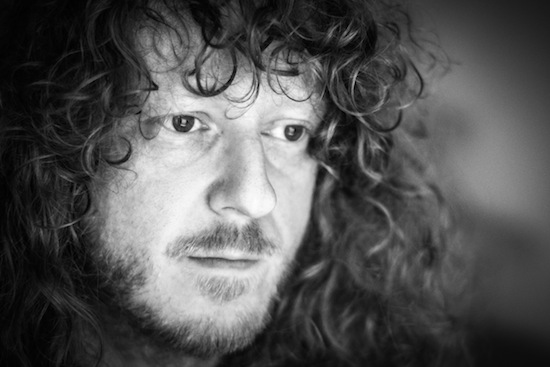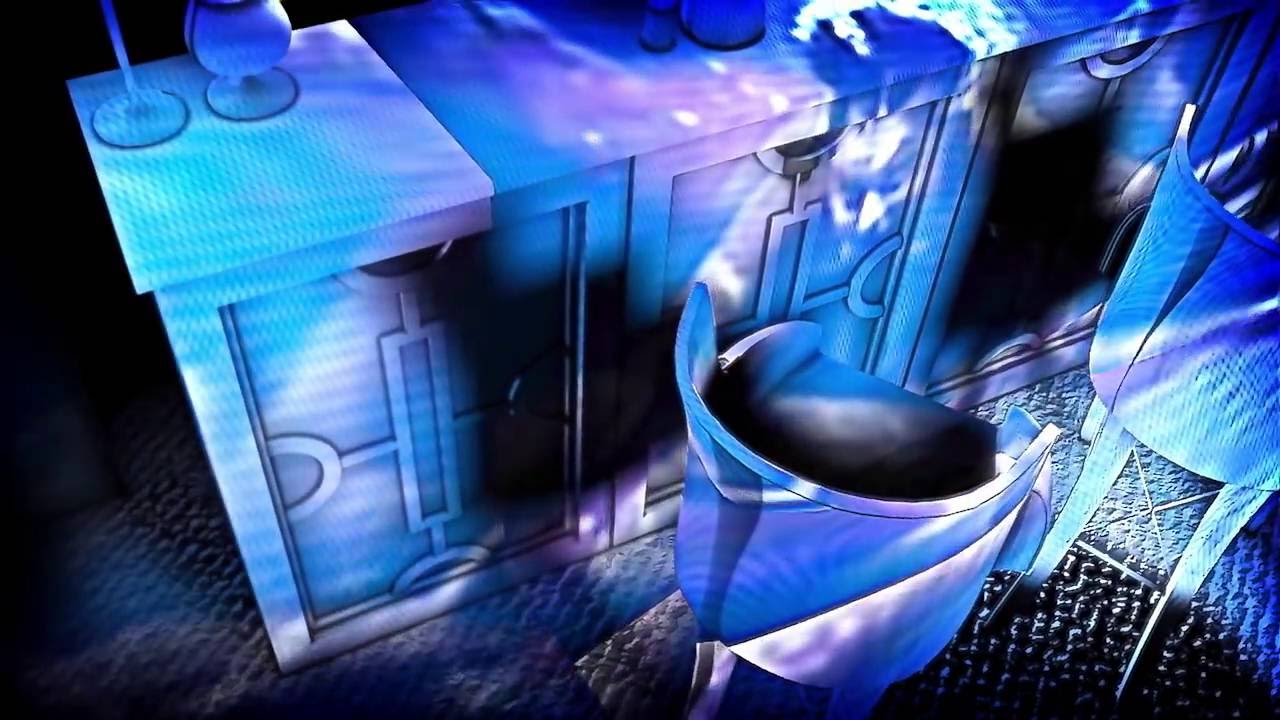All photographs courtesy of Matt Wilkinson
Everywhere At The End Of Time Stage 1 by The Caretaker is out now and the full album is streaming below
A double three to win.
I want to say there’s some kind of flash of light reflected on metal. A brief shimmer or visual disturbance as the dart leaves James Kirby’s hand; how it arcs and spins slightly before hitting the board. But there’s nothing. The light in this cool, slightly punk rock, slightly speakeasy-looking Polish bar is low, coppery and amniotic. He’s holding it between index finger and thumb one second and it’s in the double three the next.
He does a geezerish walk to the fine mesh board, which is attached to a careworn electronic Diamond Darts arcade machine that is 35 years old if it’s a day. The battered cabinet is situated dangerously close to the front door of the Propaganda bar and there has apparently been a small amount of friendly fire and even some collateral damage to unsuspecting patrons coming in for a drink over the years. The machine may be vintage but it is serviced regularly and works perfectly. The score is updated automatically via a bright red LED. The rules on the front panel of the machine are situated just below the board and are partially obscured by stickers for Polish crust punk and black metal groups. As he collects his arrows Kirby narrates the highlights of the game – in an exact copy of a TV sports commentator – with modest commendation for the victor (himself) and lavish praise for the vanquished (the author).
His darts are front-loaded. Old school. Proper. As used by his favourite player – Peter ‘One Dart’ Manley. He shakes my hand warmly and whistles approvingly: “That 140 you threw…” He puts his arrows down on the bar and nods his head in satisfaction. He has successfully drawn a line under another working day.
Every good bar has a regular like James Kirby. A raconteur with a touch of the madcap about them. A king or queen of the optics. A person who alters the energy of the room when they materialise at the bar. Someone who can appear to be controlling a hurricane of chaos around them from an eye of calm, perched atop a barstool. Someone who has an endless supply of anecdotes and a glint in their eye.
Before the interview a mutual friend tells me that Kirby has become something of a minor celebrity in the Propaganda bar; a cherished fixture among its pleasing clutter of guitars, brass instruments and punk posters hanging on the walls and its comforting aroma of beer and rolling tobacco. But this regard is not because of his abrasive remix and noise work as V/Vm; or for his haunting explorations of memory and loss via processed big band music as The Caretaker; not for his bleak electronic drone compositions as The Stranger; not as the musician responsible for 2006’s stunning ambient album The Death Of Rave (A Partial Flashback); nor as the composer responsible for 2009’s haunting piano work Sadly, The Future Is No Longer What It Was, but simply as the English guy who inspired the local darts league.

He tells me: “The bar owner Leszek set it up because I kept on going on at him. As it goes Propaganda did well, winning the first tournament; then they changed the rules and we drew the next one. All in all I think I must have played about 30 games or so losing just one when I had a migraine. They thought I was a ringer for a bit, as in one game I hit seven perfect darts in a row.”
He nods in the direction of Leszek. The bar owner, a handsome Neal Cassady lookalike, nods absent-mindedly as a an angry Russian girl tells him his bar is open too late. She knows Polish law! It should be shut by now! She storms out, he sighs, stubs out his roll-up cigarette and orders another drink before shrugging amiably at us. We do likewise. Kirby opts for a large Jameson with three ice cubes. He is very particular about his drinks. (This gin with cucumber, that one with a slice of orange – it’s not rocket science!) You get the impression that his tastes, when it comes to alcoholic beverages at least, solidified at a relatively young age.
He continues: “I was training at home every day and raised my average to about 80 around that time which is not bad for someone who doesn’t play as a pro. My mum was telling me that in his youth my granddad Leyland used to hustle people in Manchester, so the love of the game must run in the family.”
The electronic musician adopted his granddad’s name to differentiate himself from the numerous other James Kirbys out there and, perhaps, he has also adopted his forebear’s busy-ness, his need to keep moving, his heavy reliance on a quick wit and an awareness of opportunity. One big difference should be drawn however, and that is what LJK does is not a con trick of any kind. In the past he has (perhaps understandably) been labelled a prankster and a joker, and it is easy to see why if you look on Discogs at all the Falco tribute records, distressing remixes of Chris De Burgh, the reworking of the ‘Snooker Loopy’ theme released on eight different coloured 7”s and consider the live shows that consist of the musician, often dressed like a light entertainer from Hell, drinking whiskey and rolling around the stage until he injures himself. But, I’m yet to meet a convention challenging working class musician from the North West of England – where to do anything culturally outside of the norm is genuinely to stick one’s head above the parapets – who has never couched the serious art that they make in the terms of a (surreal, uneasy, caustic or offensive) joke at some point or other. It’s much more than a regional quirk, it’s a necessary survival tactic. It may seem counter-intuitive to an outsider but a sharp wit means one is not a joker. A saloon bar sense of humour means one is not pretentious. One is serious. One is proper.
I’m not the only visitor to Krakow he’s played darts with. As we prepare for another round he tells me of matches against Robin Fox, Andrew Liles of Nurse With Wound and Current 93, Sean and Miles from Demdike Stare and Lee Gamble. Kirby has a fearsome mental facility for processing numbers – with every dart that I throw he offers me an optimal if somewhat fanciful strategy for winning without pause: “Only two treble 19s and a double 19 to double out John!” And he has instant recall for how former games went (despite protestations of utter drunkenness): “Lee Gamble nearly threw a 180. It would have busted him but it would have been a beautiful thing to see… I went out on a double 20 with Andrew Liles, which was a surprise as him and his mates only turned up at 1am and by that point, we were beyond a mess…” etc.

From my perspective the culture surrounding football went through a dramatic shift in a period roughly demarcated by the release of Nick Hornby’s Fever Pitch in 1992 and Euro 96, changing the acceptability of the sport to the middle orders out of all recognition. (For all of its many many severe faults and its continued failure to apologise and make amends, it is harder to imagine The Sun’s disgusting coverage of Hillsborough happening these days.) Other staunchly working class sports such as Rugby League, darts and snooker have singularly failed to go through such a cultural decontamination process however. Darts for example, can still be a source of bewilderment or amusement to many observers whose only exposure to it has been via Bullseye or comedy sketch shows. But again Kirby’s love for the game is deadly serious.
Prior to my trip we’d had a couple of email exchanges briefly discussing darts in the terms of Zen Buddhism or Dhyana. We talked about how mastery at darts was only achievable by an ability to clear one’s mind and how training and practice could only get a player so far. How the sport was – for Kirby at least – an analog of meditation.
He says tentatively: “I think there’s something there… When you’re playing darts you do and you don’t have to clear your mind. There is concentration but you also have to be purely in the moment. There will be times when every dart you throw is going to end up in triple one. You can even think to yourself, “This is going in triple one” a microsecond before it ends up in triple one. You can tell yourself, “Don’t throw it in triple one!” And then – bang – it’s in triple one. And obviously it’s a lot harder to throw the dart into triple one than it isn’t.”
He pauses before adding: “It’s a very strange game.”
He describes how the game is essentially a one person struggle, how the opponent is actually the board not the other player. (The opponent has no real ability to alter the player’s throw. There is no tackle or snooker, they can deploy.) Interestingly, it turns out, there is now drug testing in professional darts and what they’re looking for is use of Valium or beta-blockers. Adrenaline can cause violent fluctuations in form. When a player throws two treble 20s, the surge of excitement usually sees the third dart go wide of the mark. When I throw a 140, despite not having played in well over a decade, I guiltily neglect to mention that I’m on diazepam, which I always take when travelling by aircraft. It seems maybe my artificially stilled mind has been slightly beneficial to me.
When asked how it helps him he says: “It has helped me because it means I can focus on something other than music for one or two hours after working in the studio for ten hours solid. And while you’re not focusing on what you’re working on, somehow you’re still working on it aren’t you?”
It’s like sleeping on something?
“Yeah. You have to be in the moment with darts. If I’m thinking that I have to finish a track then I will not hit anything on the dartboard. So the game forces me – if I want to do it well – to not think about anything. It is like meditation I guess. Some people meditate to clear their mind but I play darts.”
Whether darts would be a good creative solution for all electronic producers or leftfield musicians is a moot point but one thing is clear; at the moment Kirby needs this daily off switch more than ever. By any reasonable standards he has always been a very productive artist. In 2006, as part of his V/Vm 365 project, he released one track a day for an entire year. Since relocating to Poland three years ago, his average is now up to two tracks per day. And this year – the 20th anniversary of his first release – has seen his efforts double again as he is very close to announcing a special project. Some 17 years after he first devised his Caretaker persona, he has decided to kill it off with a creative act that will take three years and six albums to unfold fully.
The Caretaker was born in 1999 with the release of a short run CD on V/Vm Test Records called Selected Memories From The Haunted Ballroom, which came housed in square ziplock bag along with a monochromatically printed, blue card insert. The project was inspired by the very final seconds of Stanley Kubrick’s The Shining, a scene soundtracked by ‘Midnight, The Stars And You’ by Ray Noble And His Orchestra. It is a slow, one point perspective style, tracking shot along a corridor of a hotel corridor. A dot on the far wall slowly reveals itself to be a pre-war black and white photograph of a ballroom packed with revellers. At the front of the throng stands a smiling Jack Torrance (Jack Nicholson) with arms thrown wide. The legend, “Overlook Hotel, July 4th Ball, 1921” can be read at the foot of the photograph.
Kirby’s initial process was relatively simple and essentially involved him processing 1930s big band, swing and choral tunes recorded from old 78s with echo, reverb and other effects to produce a very spectral and dislocating style of music. After The Shining, his initial introduction to the world of pre-war dance music was via the Pennies From Heaven soundtrack LP, and then via a series of original records sourced from (the now defunct) 78 Exchange shop. After two more albums (A Stairway To The Stars [2002] and We’ll All Go Riding On A Rainbow [2003]) the project took on several extra layers of complexity with the release of 72 MP3s collected under the title of Theoretically Pure Anterograde Amnesia in 2005. This collection (which was released as a six CD set the following year), marked a change in direction for the project conceptually, as it started to explore different aspects of memory loss as the music itself became more texturally and structurally complex.
The work of The Caretaker began to attract critical attention and a small but devoted fanbase; and this momentum only grew stronger with the release of such albums as Persistent Repetition Of Phrases in 2008 and the acclaimed An Empty Bliss Beyond This World in 2011. (The latter was influenced by a specific late stage of Alzheimer’s Disease in which the sufferer is so far gone they are no longer aware they have a problem – hence the ragged bursts of euphoria as well as violent edits.) And apart from the OST to Patience (After Sebald) in 2012, things have been quiet on The Caretaker front since. But this is not to say that Leyland James Kirby has been resting on his laurels. In fact quite the opposite is true.
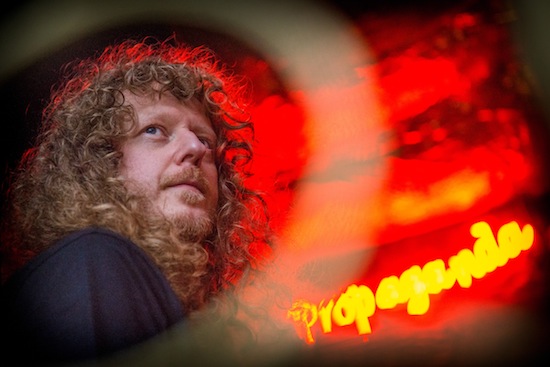
He tells me about the next and final stage of the project. How he will release a series of six records, called Everywhere At The End Of Time which will come out in half-yearly instalments, tracking not just a mind succumbing to dementia through all of its stages, as if in real time but the entire project itself dissolving through forgetfulness, into chaos and then nothingness.
“I think I’m coming to the end of The Caretaker. I just can’t see where I can take it after this. My final idea has been to give the whole project dementia. Originally I was going to make one recording and take it down into the abyss over a period of three years. So the idea would have been to do one recording and degrade it, to process it down so you would get a continuation from the start to the end point. But then I thought, “Wouldn’t it be better to give the whole project dementia?” That then forces me to think, “Well, what do I remember from the project myself?” Because it’s nearly 20 years since I started making the first record. And then I developed this idea of doing six releases each with a gap of six months between each one to give a sense of time passing.”
Can you explain specifically what you mean by this? Will you use all of the previous Caretaker releases as source material?
“Yeah, the old records will come back into play as things start slipping. So to start with, everything is new. The first one is really like an old person daydreaming. When I was getting it mastered I knew I wanted it to be really rich, really big, really consistent sounding all the way through. The interesting thing is the switch between the first and second album. The second one is a massive difference between the moods. The second one is the point where you realise that something is wrong. You’re seeing doctors. You’re still coherent enough to say, “Right, I’ve got dementia…” You know this thing is coming. There’s a bit of disbelief. I’ve been doing a lot of reading into it; I’ve bought a lot of books and done a lot of research online. You probably try and remember more than you usually would at this stage. So on the second LP there are actually full tracks but things are missing, sections have been stripped away. It’s not necessarily just composed of small loops.
“I’ve just started working on the third album, I’ve done a lot of tests for all of them and the work will be ongoing throughout the whole series. From the third record we get almost to An Empty Bliss stage. The reasoning behind me doing this project however is for me to take it forward further still. It’s only regarding the last three stages of the disease where I’ve not attempted to do anything yet. How do you make complete confusion a good listen? That’s the challenge for me. And I need that challenge.”
People who buy the first album digitally from Bandcamp or Boomkat will automatically get all six releases, as they come out over the three year period. There will also be physical copies of all of them – a series of vinyl LPs and a couple of three CD sets (released at the halfway mark and the endpoint). Kirby says that the first three in the series should contain interchangeable tracks, that they could be left on shuffle as a set but after the halfway point the degradation will become much more severe. Ivan Seal, the Stockport artist responsible for a lot of Kirby’s record sleeves will creating the album art.
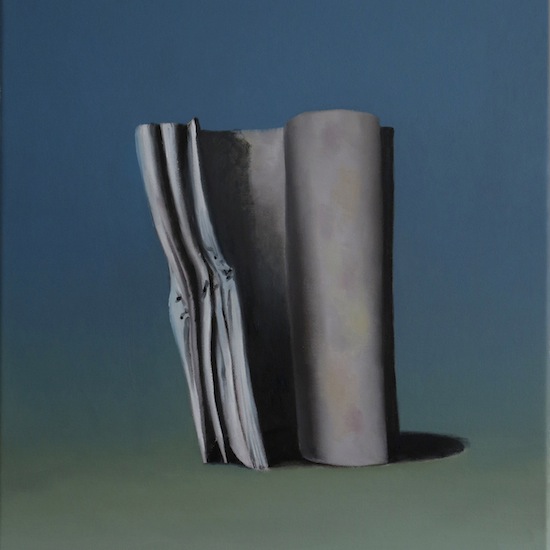
Everywhere At The End Of Time by Ivan Seal
He says he has completed the first two albums, is working on the third and has a clear idea of what will happen in the whole series: “Memories from the whole 17 year project will start cropping up, probably on the third album. I’ve got a feeling that either the fourth or fifth might actually be a double album. For that I’ll be doing 30 or 40 minute tracks which are essentially self-generating. And then I have to find specific points in those tracks which are interesting and edit them down. For the sixth one, what I’m interested in is what happens when you strip certain frequencies away. The software exists for you to do this now.”
He is resigned to the fact that in today’s culture of instant reaction, he will probably be judged on the first instalment rather than all six together but he is clear that he has finally come up with the kind of unique closing idea that the project deserves: “I know it’s not the same as what I’ve done before but I also know what people will say when they hear the first one. “Oh, it’s just the same, he’s just looping parts of big band records.” But these parts have been looped for a specific reason and I’ve chosen specific tracks for a reason which will become clear down the line.”
I am momentarily reminded of John Doe, Kevin Spacey’s serial killer character in Se7en giving his show-stopping monologue in the back of a police car, when he says emphatically: “At the end of this it will all become clear.”
(This said he’s not convinced that his approach will be met with universal approval when the sixth record comes out either… but he actually seems quite enlivened by this prospect: “There is a certain type of listener who will be buying this for a particular type of sound. And they will get this particular type of sound at one stage. But by buying it they will be forced into different areas [of listening]. Because dementia’s not nice is it? So the later stages of the project are not going to be that nice. The first album is warm and great but it’s not going to be like that at the end. And I like the idea of forcing people to listen to stuff… and I think if they’ve bought it they’re more likely to listen to it aren’t they? It’s a bit like when someone gets dementia, at first not much changes but by the end very few people want to visit them. I think that element will be in play. But even if they only listen to it once and say, ‘What the hell is this? This is nonsense.’ That’s fine. Then I’ve done the job correctly. That’s how it should be.”)
When I push him about what he means when he says “it will all become clear”, he reveals that rather than just process the same records over and over to achieve the kind of ‘slippage’ that he wants, one of his tactics has been to source multiple versions of the same songs, allowing him to use the same musical phrases while generating many different emotions: “These days I have more options than I did at the start. It’s now possible to find a lot of this music online and it’s easier to research. The possibilities are huge. It’s possible to find ten versions of one song now. You can compare the same section looped from each song. So it’s almost like you have one memory but you’re hearing it with a different mood. I’m playing a lot with this idea on the new one. As a listener, when you go through the series, you will know that you’ve heard a particular section before but it will sound different. On the first album there’s one specific song that I used on the opening track which is very, very upbeat, nice and really warm. For the second album I managed to find a different version of the same song but somehow the guys playing it sound… low. There’s just a low mood to it – like the band haven’t had a coffee yet.”
The context is important: “I’ve been thinking about Everywhere At The End Of Time properly for about a year and a half now and then about six months ago I started mentioning it to a few people because I wanted to be sure it didn’t come across as this highbrow, pretentious idea. “Oh, he’s giving it all this now…” The only way I could take people somewhere new was to do it this way but if I had just put out an album that was completely confused it wouldn’t make any sense. It needed the context of the whole series to make sense.”
It does feel as if things are coming to a natural head regardless. He has made 200 Caretaker tracks over the last 18 months and, by his estimation, will have made over one thousand for Everywhere by the end of the project. By August this year, he had already made more Caretaker tracks than he had in the other 16 years of the project combined. When asked if he’s put himself in a position where he has to pull the plug on it, he answers: “More or less, yeah. There are possibly a couple of ways to do something else but it would be more on an experimental scale.
“For example, I could say, ‘What if a new drug came along to tackle Alzheimer’s – how would that affect the concept as regards this project?’ It would still be possible to do something like that but I can’t carry on for another ten years looping old 1920s music.”
The project has successfully traversed a technological divide since inception. Initially the 78 would be played through a fucked old mixing desk, via a BOSS effects unit before being recorded onto DAT or minidisc: “That’s why there are a lot of full tracks on the first release going through a process. It was difficult to loop then because the software didn’t exist.” He is now fully “in the box” and uses “a very powerful” computer which was designed specifically for the production of music.
He says the sophistication of the tracks in 2016 is down to a much deeper understanding of his process, a wider array of creative techniques, much more powerful hardware and better access to source material. He is of the opinion that if people think what he does is easy, they are free to try it themselves.
I ask him if there will be a big Caretaker-shaped hole in his life when it’s gone, he shakes his head and laughs. He tells me he’ll let me listen to everything else he’s been up to for the last three years tomorrow. He warns me that it may take some time.

Inside James Kirby’s flat the following day it’s a bit parky. His artist girlfriend Anna points out of the window mock disconsolately. “Outside it is the beautiful Polish summertime and is 28 degrees centigrade but in here… James makes sure it is like a fridge.” He makes a dramatic entrance sliding into the room in his stocking feet. He cuts quite a dash, tall, slim and handsome with a, let’s say, signature haircut which makes him look like a strawberry blond Charles I or a youngish Ian Hunter (my words) or, if you prefer, “a poor man’s Joey Tempest or David Coverdale throwing for the bull from the oche of life” (his words). He spreads his arms wide as if to embrace the chill: “Feel that! Just like Manchester…”
Kirby was born in Stockport in the mid-70s. One of his first musical obsessions was with Frankie Goes To Hollywood – an obsession that still stands today as he claims the only record in their back catalogue that he is missing is the one-sided, white label, 7” warp remix of ‘Relax’. This obsession led eventually led to one of V/Vm Test Records most berserk releases, Relax: The Full Story, the 2003 compilation of 24 different unofficial remixes of FGTH’s most famous song (mostly made by Kirby himself under various names). He tells me ZTT’s lawyers were sending him close to incomprehensible 24 page long legal documents threatening to sue him for large sums of money over the compilation and only stopped when he smashed a pile of the albums up with a hammer and posted a box full of the shards to their offices.
His first exposure to “electronic music” was seeing Farley ‘Jackmaster’ Funk and Darryl Pandy performing ‘Love Can’t Turn Around’ on TOTP in 1986, which then led to the purchase of a commercial compilation of early Chicago house and acid. Kirby then started hearing a wide selection of electronic dance music at a weekly under 18s disco in Manchester as well as buying imports from record shops in town. In 1990, his final year at secondary school, a conversation about music with fellow pupil Andy Macgregor, led to a deepening interest in rave and darker electronic sounds. It turned out that Andy’s dad, Acid Alan, was something of a DJ fixture on the Lancastrian rave scene and turned the boys onto R&S records, Belgian new beat and other unusual and ground-breaking electronic sounds of the day.
By the time the pair left school, they were throwing teenage parties themselves, DJing at Monroes, a club in Stockport as well as making music together (the period would go on to inspire The Death Of Rave (A Partial Flashback)). They would eventually start V/Vm Test Records together in 1996, with Andy releasing music as Jansky Noise and Animal. Despite his tastes and the proximity, Kirby always felt apart from the scene in Manchester though: “I never went to the Hacienda. I went to clubs that were slightly darker, like Konspiracy where there was a bit more of an edge. I was into the music, not the scene. I’ve never liked scenes.”
He says he can no longer understand where his energy for the V/Vm project came from. How in one year alone he released 30 records under that name, recording, pressing up and distributing them all on his own. But even with such a prolific work rate the idea of being able to keep his head above water making such abrasive art with no other source of income became untenable – especially after his work started attracting attention from copyright lawyers – so he moved to Berlin in 2006.
He is now ambivalent about his six year stay in Germany: “It was too messy… too disruptive… too many people visiting every weekend. They’re not coming over to play Scrabble are they? They’re coming over to go out so I was out as well. That was it. It was endless. I was doing work in between but I knew I had to get out of there so I could do better work and more of it. And so that I could look at the work more intensely.
“I never listen to my own music once it’s out but I had reason to listen to An Empty Bliss Beyond This World recently and it just brought it all back to me. The dingy flat I was living in, the constant noise from the guy stomping about in the flat upstairs, the shitty equipment I was using, the long walks every day across town listening to Time Is A Thief by Joe Fagin on headphones…. The endless bars.”
He moved to Poland in 2012 because he had friends in Krakow and now he finds it much easier to work. Apart from a couple of nights out a week playing darts at Propaganda he doesn’t go out much. He’s only been out clubbing once recently and then he spent all night talking to Andy Stott about the renovation of a Mk 1 Ford Escort, rather than dancing. The time before that he attempted to go and watch LFO and Autechre at the Forum Hotel in 2014 with his pal, the old school DJ, George Northface, after the pair had drunk a bottle of “Clan Macgregor Whiskey” – a present from Acid Alan – at home. This was a night which culminated in him getting lost in the fog, falling over a fence, somehow missing all of the music and then waking up in a pool of blood back at his flat after accidentally knocking himself out on the window ledge.
He nods at a bottle of Jameson on the kitchen counter: “That’s just for show. I don’t drink at home any more.”
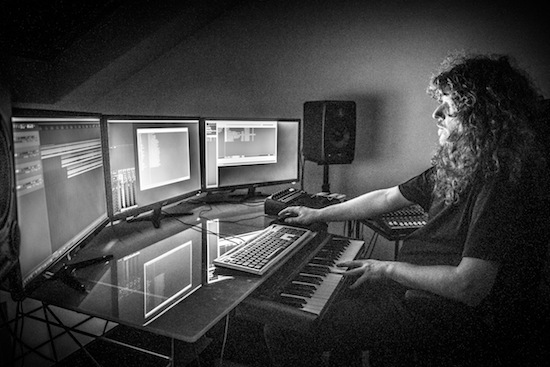
Up a small flight of stairs is his studio, where he lets me look through the archive of all the music he’s made since moving here two and a half years ago. There are somewhere between two and three thousand tracks in numerous different (mainly new) styles.
He is quick to dismiss the idea that there is anything unusual about producing this much music: “Two tracks a day is an average. Sometimes it’s ten tracks in one day and other times it’s none. It’s all about which sounds work together well and once you work out what they are, it then becomes about the different ways you can present those sounds together. So I’ll do one track but ten different versions of it, always looking for the optimal take.”
He starts playing tracks at random while saying: “It’s nuts. It’s crazy. Very few people get to listen to it but when they do they always say, ‘Where would you begin with compiling all this?’ Say if I wanted to release an album of piano music, I’ve got between 600 and 700 piano tracks finished. How do you pare that back to six or seven tracks? Sometimes it feels like it would be easier just to do six or seven tracks from scratch.”
He says his new ‘modern classical’ pieces are “totally focused” now and that the sound quality is better because his hardware is better and he has more time: “Time is how I get paid now. I don’t look at any amount of cash as an objective. My objective now is to have blocks of time. It’s another reason I don’t play live, because if I’ve got a show coming up, it’s on my mind and I don’t have a clear head and I can’t work as well.”
He plays me another batch of music which reminds me of the Necks, if they were on tranquillisers. He says: “This was inspired by watching Béla Tarr’s Damnation. I know everyone talks about Tarkovsky with such reverence but why don’t they talk about Tarr the same way? I think they’re very similar filmmakers. I imagined a bar from one of Tarr’s films and thought, “What would the house band sound like?” I could picture someone on an old 80s DX synth in the corner while a fight’s kicking off or there’s some chaos going on. The tracks don’t necessarily go anywhere but then neither are the people in the bar.”
Another batch of music utilises a soft cello and is dubbed Krakowski Koń or the Krakow Horse, by Kirby, after a 100-year-old picture of a horse in the city square: “This music is finished but I need more of a concept to hang it off. In this picture, the horse looks so sad. The cello sounds dysfunctional. It goes well with the drums. I spend a lot of time getting the balance of sounds right and it’s only happening now because I’ve got better speakers finally. For years I was working on bad equipment and no money.”
One really gripping strain of music has the vague overtone of Gnaw Their Tongue’s All The Dread Magnificence Of Perversity to it but coming in from the modern classical angle rather than the extreme metal side of things: “This distressed flute and trombone music could be a way for taking The Stranger forward. It’s like a dark Les Baxter. It’s just horrible. It’s like elevator music that’s gone wrong. The home studio I use now was really built for pre-production on Hollywood soundtracks, they use this set up to compose before they get the real orchestra in. And that’s what this music is: Hollywood gone wrong. The only reason I’ve not done anything with this style is the fact that I’ve only completed eight or nine tracks of it and really I need to complete 50 or 60 to choose from.”
He plays me various examples of new Belgian new beat and techno he’s been working on and some other styles that I can’t fully remember or classify. We pour through his archive for about two or three hours but barely seem to have scratched the surface when we stop. It seems clear that he probably won’t miss The Caretaker too much after he’s gone.
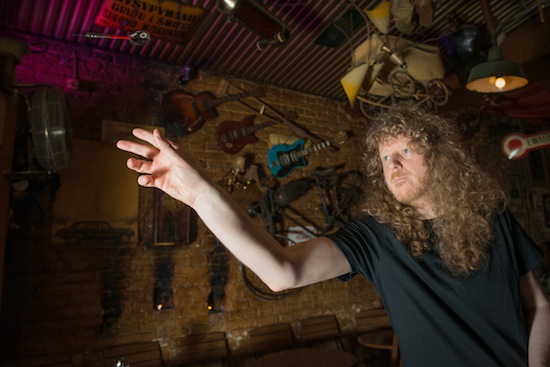
We head out for lunch before I fly home and James and Anna start telling me about local characters, including the implausible sounding Tree Man. This is the local nickname for a Krakow resident who goes out drinking with small branches and twigs glued to his head and then tries to grab hold of people and spin them round.
“He’s a dentist apparently”, says Anna, before adding darkly: “He has lots of clients and a very big practice but he cannot be sacked. He is too well connected.”
As they wave me off James shouts after me: “If you see Tree Man, whatever happens, don’t let him fucking get his hands on you. He’ll spin you round and round until you’re devoid of all sense. He’ll spin you ‘til you can’t stand up any more. If you see him, I’d just head in the other direction because once he’s got hold of you, he’ll never let go.”
Everywhere At The End Of Time Stage 1 is out today via Bandcamp and Boomkat

